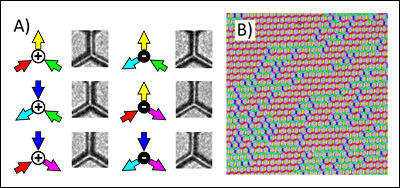News Story
Rabin Wins Prestigious NSF CAREER Award for Spectroscopy Research
A proposal that combines optics, chemistry, and nanoparticle engineering techniques to identify and separate materials based on their molecular structure has earned Clark School assistant professor Oded Rabin (Department of Materials Science and Engineering [MSE]) a five-year, $540,000 National Science Foundation (NSF) Faculty Early Career Development (CAREER) Award.
Rabin, who holds a joint appointment with the Institute for Research in Electronics and Applied Physics (IREAP), was recognized by the NSF as an outstanding junior faculty member who effectively integrates research and education.
His proposal, titled "Plasmonics with a Twist—Chiral Nanostructures for Advanced Spectroscopy," describes how nanostructures engineered with unique optical properties can be used to enhance spectroscopy, a collection of techniques that allow researchers to identify and quantify chemicals based on how they scatter or absorb light.
The work focuses on molecules described as chiral, a term applied to those that exhibit a "handedness." Like hands, chiral molecules are found in "left" and "right" configurations. And like a person's left and right hands, they may not perform the same task in the same way or as effectively. Proteins, DNA and most molecules that naturally occur in all living things are chiral.

Nature is abundant with structures exhibiting Chirality or "Handedness." Professor Oded Rabin captured these images of magnificent chiral cacti during a visit to the botanical gardens. His spectroscopy tools capture signals from molecules and nanostructures with similar shapes, but (much, much) smaller in size.
Being able to tell and separate "left" from "right" becomes crucial in drug production, where one configuration could have a beneficial effect while the other has none, or even a toxic one. It is very difficult and very expensive to synthesize completely pure drugs whose molecules exhibit a single configuration.
Rabin and his group want to enhance the sensitivity and accuracy of the optical measurement tools used to determine the identity, ratio, and concentrations of left and right molecules in a sample.
In prior research, Rabin investigated the use of plasmonic (metallic and highly conductive) nanoparticles—in that case silver nanocubes—to enhance the sensitivity of Raman spectroscopy.
In the new study, Rabin and his group have designed novel plasmonic nanoparticles that resemble pinwheels oriented to the left and right. After these particles have been mixed with chiral molecules, the whole sample is exposed to a beam of circularly polarized light, which, like the chiral molecules, has "left" or "right" attributes.
"When light is circularly polarized, it means that its electric field is spinning around, clockwise or counterclockwise, as the beam travels," Rabin explains. "It's like throwing a football. The ball travels along a path, and spins as it goes."
When the circularly-polarized light illuminates the sample, it sets off sophisticated and selective interactions. Molecules with a left configuration will absorb the "screw-like" light differently than those with a right configuration, just like a left hand will fit more comfortably in a left-handed glove than a right-handed one. The nanoparticles make this selectivity more pronounced, allowing the spectrometer to detect and identify the target molecules at much lower concentrations.
While pharmaceutical companies would benefit most from Rabin's technique in the near term, it could also help researchers observe and study the progression of diseases such as Mad Cow disease, in which proteins, chain-like molecules which need to fold in a precise manner in order to function, refold in an incorrect and ultimately deadly way.
Rabin is the third MSE faculty member in the past year to receive a CAREER Award, preceded by assistant professors John Cumings and Joonil Seog in 2011.
Visit the NSF CAREER Award web site »
Visit Professor Rabin's homepage »
Visit Professor Rabin's Materials and Interface NanoTechnology web site »
Published February 9, 2012











